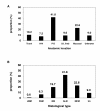Clinical presentation, histology, and prognoses of malignant melanoma in ethnic Chinese: a study of 522 consecutive cases
- PMID: 21349197
- PMCID: PMC3056833
- DOI: 10.1186/1471-2407-11-85
Clinical presentation, histology, and prognoses of malignant melanoma in ethnic Chinese: a study of 522 consecutive cases
Abstract
Background: Malignant melanoma is a rare disease in Asia, and knowledge on its characteristics and clinical outcome in Asian patients is limited. The purpose of this observational study was to determine the clinical presentation and outcome of patients with melanoma in China.
Methods: A database was prospectively established for the purpose of this analysis. The elements of the database included basic demographic data of patients and prognosticators previously reported in literature, as well as follow-up data including clinical outcome after treatment. Medical record of all patients with pathologically diagnosed malignant melanoma consulted in our center since 2006 were retrieved and reviewed. No patient was excluded in this study. Statistical analyses including survival and multivariate analyses of factors associated with survival were respectively performed by Kaplan-Meier method and Cox proportional hazard model.
Results: A total of 522 consecutive and nonselected cases were evaluated. There were 218 cases (41.8%) of acral lentiginous melanoma (ALM), 118 (22.6%) of mucosal melanoma (MCM), 103 (19.7%) of nodular melanoma (NM), 33 (6.3%) of superficial spreading melanoma (SSM), and others were Lentigo maligna melanoma or unclassifiable disease. The proportion of patients with clinical stage I, II, III, and IV diseases were 6.1%, 55.9%, 25.1%, and 12.8%, respectively. Among the 357 cases of cutaneous melanoma, 234 patients (65.5%) had ulceration.The 5-year overall survival rate of all 522 patients was 41.6%, and the median survival time was 3.92 years (95% CI, 3.282 to 4.558). Five-year survival rates of patients with stage I, II, III, and IV diseases were 94.1%, 44.0%, 38.4% and 4.6% respectively (P < 0.001). Multivariate analysis revealed that clinical stage and the ulceration were two significant prognosticators for OS. In addition, extent of surgery and use of adjuvant therapy were significant prognosticators for DFS in patients with non-metastatic disease after definitive treatment. Pathological subtype was not a significant prognostic factor to predict wither OS or DFS.
Conclusions: Prognoses of patients with malignant melanoma diagnosed in China were suboptimal, and most patients were diagnosed with locally advanced disease (i.e., stage II or above). ALM and MCM are the two most commonly diagnosed pathological subtypes. Clinical staging and presence of ulceration was significantly associated with clinical outcome in terms of OS, while treatment strategy including extent of surgery and use of adjuvant therapy were significant predictors of DFS.
Figures



References
-
- Curado MP, Edwards B, Shin HR, Storm H, Ferlay J, Heanue M, Boyle P. Cancer Incidence in Five Continents. IX. IARC Scientific Publications No. 160, Lyon: IARC; 2007.
MeSH terms
LinkOut - more resources
Full Text Sources
Other Literature Sources
Medical

